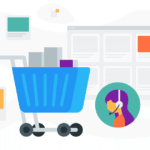Benefits of Ecommerce For Customers and Businesses

As of 2024, there are 2.71 billion online shoppers globally*—meaning 33% of the world’s population is shopping online.
This means that to reach customers where they are, an ecommerce store isn’t just a nice-to-have—it’s a must.
Shopping online offers unmatched convenience and product selection. Meanwhile, it gives businesses the ability to tap into a bigger customer base and better appeal to customer needs through valuable shopping data and analytics tools.
In this post, we’ll dive into how ecommerce opens up new opportunities for both shoppers and businesses and why it’s a smart move to include it in your digital marketing and sales strategy.
Key takeaways:
- Ecommerce offers unmatched convenience and a broader selection for customers, making shopping easier and more personalized.
- For businesses, ecommerce reduces overhead costs, expands market reach, and enhances customer insights, through tools like call center analytics software.
- CloudTalk’s advanced features can help businesses optimize their ecommerce operations, enhancing customer interactions and driving growth.
Optimize your ecommerce operations with CloudTalk
Understanding Ecommerce: More Than Online Sales
Ecommerce is much broader than having an online business and simply selling goods over the internet. Ecommerce site lets organizations manage customer relationships globally by reaching more potential customers and demographics than they would with a physical storefront.
But it’s not just about market reach and an online presence. It’s about using the latest tech, like artificial intelligence, data analytics, and cloud computing to help you create personalized shopping experiences that set you apart from the competition (and on search engines). To make most of it, businesses must ensure they have the right e-commerce team structure to manage these tools and create personalized shopping experiences.
For example, an ecommerce company can use CloudTalk’s retail calling solution to improve sales and customer support. With advanced features like CRM integrations and Automatic Summaries and Tags, sales and customer service teams can easily give personalized recommendations in real time. This can boost customer satisfaction and loyalty to your brand—and increase online sales.
Types of Ecommerce Models
The global B2C ecommerce market reached $4.8 trillion in 2023 and is projected to nearly double to $9 trillion by 2032. This is just one example, however, since ecommerce applies to various business models, each serving different needs. Here are the main types:
- Business to Consumer (B2C): Businesses sell directly to customers. For instance, if you purchase apparel from an online-based company such as Amazon or Zara, you participate in B2C ecommerce.
- Business to Business (B2B): In this setup, businesses sell to other businesses instead of directly to customers. For example, Alibaba sells products in bulk to other companies, which then sell those items in their own stores.
- Consumer to Consumer (C2C): Individuals market to each other through sites like eBay and Craigslist. For instance, selling your old phone online through eBay.
- Consumer to Business (C2B): Here, individuals sell products or services to businesses. An example is a freelance graphic designer seeking design jobs through freelance sites such as Fiverr or Upwork.
- Business to Government (B2G): Organizations supply merchandise or services to the government or one of its departments. For instance, a communication solution provider firm selling software applications to a governmental agency through a B2G contract.
- Business to Business to Consumer (B2B2C): This is a mix where a business sells to another business, which then sells to the final customer. A typical example is a food manufacturer selling products to a retailer, like a grocery store, which then sells the products to consumers.
The Advantages of Ecommerce For a Customer
Now that you know the types of ecommerce, let’s investigate how online shopping transforms the customer experience. For instance, it offers customers several benefits, including:
- Convenience
- Wide selection
- Price comparisons
- Personalized shopping experience
- Access to customer reviews and ratings
#1 Convenience
With ecommerce, people can shop from anywhere, anytime, without the constraints of store hours or geographical locations. This 24/7 availability makes it easy for customers to find what they need, whether they’re at home, at work, or on the go. You also get plenty of payment options, so you can make a purchase using third-party vendors like PayPal, debit, or credit cards.
#2 Wide Selection
71% of people find comparison sites helpful since they show you a ton of options all in one place. Shopping online gives you access to a bigger range of products than you’d find in physical stores. You can easily check out different brands, styles, and models, making sure you find exactly what you’re looking for without being limited by what’s in stock at a local store.
#3 Price Comparisons
Shopping online makes it easy to compare product information and prices across different sites so you can get the best deals. That’s why 78% of online shoppers use price comparison tools to make sure they’re getting the most value for their money.
#4 Personalized Shopping Experience
Online stores often track user browsing habits and past purchases to suggest personalized products. This makes shopping more enjoyable and also boosts buyer confidence since they’re more likely to feel understood and valued. Take it from the 60% of shoppers who say they feel more confident in their purchases with a customized online experience.
#5 Access to Customer Reviews and Ratings
Before you hit “buy,” you can check out product descriptions, reviews, and ratings from other shoppers, helping you make smarter decisions. Reviews are a big deal—77% of people say they rely on them to guide their purchases, which makes the shopping process feel more trustworthy and reliable.
Advantages of Ecommerce For a Business
When you deliver a great, user-friendly experience, customers are likely to come back for more. Ecommerce isn’t just beneficial for customers, however; it also offers numerous advantages for business owners. We’ve already hinted at what these advantages might be, but let’s take a closer look:
- No overhead
- Broader market reach
- Enhanced customer insights
- Improved inventory management
- Flexibility and agility
#1 No Overhead
One of the biggest perks of having an ecommerce website is saving money. No need for expensive storefronts, rent, or in-store staff. Since it’s so cost-effective, you can put those savings into other important areas like improving your products or marketing efforts.
#2 Broader Market Reach
Ecommerce lets you connect with customers all over the world, not just in your local area. With 56.6% of shoppers preferring to buy online, having an ecommerce platform and presence is key to growing your brand and boosting sales.
#3 Enhanced Customer Insights
Considering 54.6% of people leave a brand after one bad experience, understanding your customers is more important than ever. Through tools like Sentiment Analysis, Topics Extraction, and a Real-Time Dashboard displaying call center metrics, you can access crucial customer data such as what they like, what they buy, and how they shop.

#4 Improved Inventory Management
With ecommerce, businesses can manage their inventory more efficiently. Automated systems keep track of inventory in real-time, so you know when it’s time to restock. This helps you avoid running out of popular items or over-ordering items that don’t sell.
#5 Flexibility and Agility
Whether you’re launching a new product or reacting to market trends, ecommerce allows businesses to quickly adjust and keep up with customer demands. These operations can be optimized with tools for call center monitoring, ensuring quality customer interactions and consistent service delivery.
How did Nokia benefit from centralizing data with Cloudtalk?
- 30% Boost in outbound success rates
- 10% Increase in agent productivity
- 25% Decrease in leads lost

Disadvantages Of Ecommerce
While ecommerce offers many benefits, it’s essential to acknowledge its challenges. These mainly involve:
- Shipping and returns logistics
- IT issues and security threats
- Limited connection with customers
- Competition in digital commerce
#1 Shipping and Returns Logistics
Customers expect fast and reliable delivery, and managing this process can be costly and challenging for businesses. Therefore, handling returns efficiently and lowering shipping costs is crucial for maintaining customer satisfaction.
#2 IT Issues and Security Threats
Ecommerce relies heavily on tech, making it vulnerable to IT issues and security threats. In 2022, 91% of ecommerce businesses reported at least one cyber incident and online payment fraud which caused $41 billion in losses globally. Keeping your systems secure is a must.
Pro tip
Use a cloud provider with complete data protection to help secure your ecommerce operations—especially when customers need human contact and support.
For example, CloudTalk’s secure data handling and compliance with GDPR and HIPAA protects your customers’ data for worry-free interactions. This helps you build trust and boost customer satisfaction across crucial customer touchpoints—and close more sales.

#3 Limited Connection With Customers
Without face-to-face interactions, it’s harder to connect with customers.
For instance, imagine shopping for a high-end camera online—you might have a lot of questions about features, compatibility, and reviews that you’d typically ask a knowledgeable store clerk in person. While tools like chatbots can provide some answers, they often lack the personal touch and nuanced responses of a real conversation.
Pro tip
Connecting with your customers through advanced customer support solutions can enhance real-time communication and improve the overall customer experience.
#4 Competition in Digital Commerce
The online market is super competitive, with businesses worldwide on various eCommerce platforms trying to grab customer attention. To stand out, you need smart marketing strategies, a strong brand, and a clear understanding of customer needs.
Using tools that monitor sales and customer service performance and optimizing your Talk/Listen Ratio can give you that extra edge in connecting with customers and staying ahead.
Elevate Your Ecommerce Strategy With CloudTalk
Ecommerce transforms how businesses operate and customers shop, offering a wide range of benefits for both. This includes convenience and personalization for customers, and broader market reach for businesses.
However, it’s essential to be aware of the challenges, such as shipping logistics, security threats, and competition, and learn how to address them effectively.
One way to overcome these challenges is by leveraging CloudTalk’s advanced features like its Real-Time Dashboard and Sentiment Analysis. This lets you monitor interactions, streamline support communication, and gauge customer emotions as they arise. This way, you can build stronger relationships, boost sales, and maintain a competitive edge.
Whether you’re looking to improve call center performance or make customer service an integral part of your ecommerce processes, CloudTalk has the tools you need to succeed.
Experience the advantages of CloudTalk alongside industry leaders like Fujitsu, DHL, and Deel
FAQs About the Advantages of Ecommerce
What are four advantages of ecommerce?
The four main advantages of e-commerce are:
#1 Convenience
#2 A wide selection of products
#3 Price comparisons and
#4 Access to customer reviews
These benefits make shopping easier and more personalized for customers, allowing them to find the best deals and make informed decisions.
What are the disadvantages of ecommerce?
The main disadvantages of ecommerce include:
#1 Shipping and returns logistics
#2 IT issues and security threats
#3 Limited connection with customers and
#4 Intense competition in digital commerce
These challenges can impact both customer satisfaction and business success, making it crucial for businesses to address them effectively























